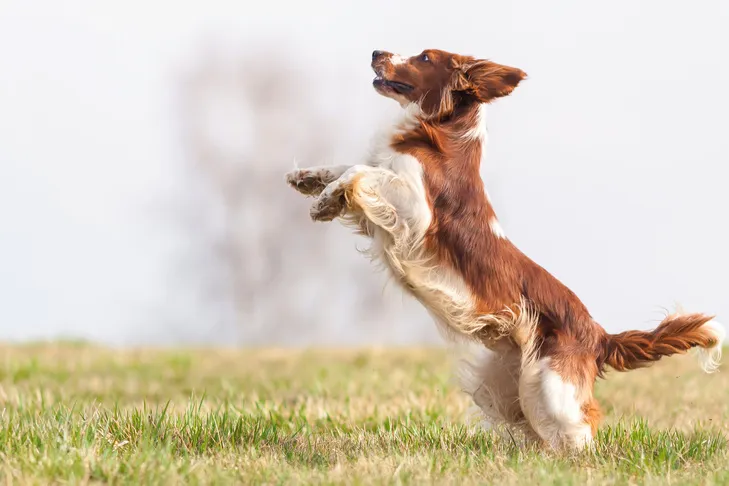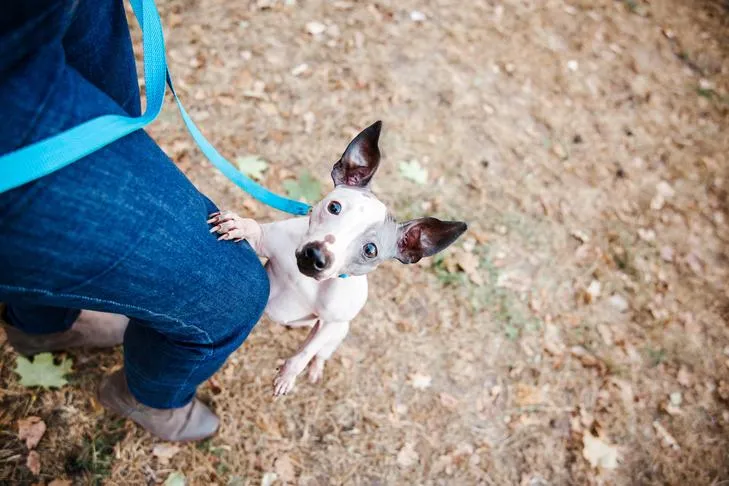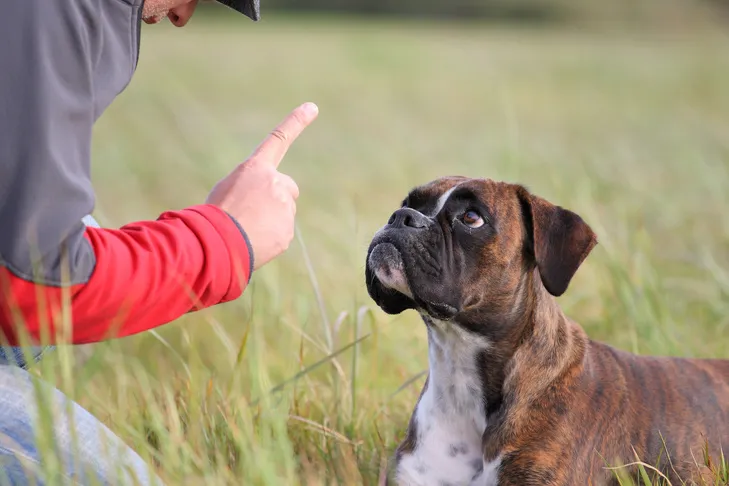Few things are as heartwarming as a puppy bounding towards you, tail wagging furiously. But when that enthusiasm translates into jumping, it quickly becomes less charming and more problematic. A puppy jumping on you can scratch, dirty clothes, or even knock you over, especially as they grow larger. While it’s a natural way for puppies to seek attention or greet you face-to-face, it’s a behavior that needs gentle guidance. If you’re wondering How To Make Puppy Stop Jumping On Me, the key is to teach your furry friend a more polite and safer way to say hello.
Instead of just telling your puppy what not to do, we’ll focus on teaching them an alternative, acceptable greeting rule, such as “four paws on the floor.” This approach is far more effective for puppy training, empowering them to understand exactly how to earn your attention and affection. By implementing these 10 practical tips, your puppy will soon learn appropriate greeting behaviors, transforming their boisterous hellos into calm, enjoyable interactions.
1. Only Reward When All Four Paws are on the Floor
The most effective strategy for managing unwanted puppy behavior is to teach an incompatible alternative. Your puppy will learn faster if you guide them towards what to do, rather than solely focusing on stopping an undesirable action. For instance, if your puppy is jumping, teach them that greetings only happen when all four paws are firmly on the ground. They cannot jump and stand politely at the same time. Alternatively, you might teach your puppy to sit or lie down for greetings. Whatever rule you choose, be consistent: only provide attention, praise, or petting when your puppy is following this rule. This means no exceptions, whether you’re in casual clothes or dressed up.
2. Give Immediate Attention When Your Puppy Stays Down
Puppies are masters at repeating behaviors that yield desirable results. Since your puppy likely jumps to gain your attention, it’s crucial to reinforce the correct behavior immediately. The moment your puppy’s front feet touch the floor after an attempt to jump, or if they greet you with all four paws down from the start, lavish them with praise and gentle petting. Your attention is a powerful reward, so make sure they receive it without delay. If you wait to remove your coat or put down your bags, your puppy might become impatient and revert to jumping to get you to notice them, undermining your training efforts.
3. Remove Attention When Your Puppy Jumps
Conversely, the only way to discourage jumping is to ensure it never earns a reward. If your puppy jumps on you, promptly withdraw what they’re seeking: your attention. This could mean turning your back to them or calmly walking away and stepping into another room. This teaches your puppy that jumping has the opposite effect of what they intended. However, the second your puppy has all four paws back on the floor, turn around and quietly offer praise and petting. This helps your puppy understand that their behavior acts like a switch, turning your attention on and off based on their actions.
 A Welsh Springer Spaniel puppy enthusiastically jumping up outdoors, trying to greet someone.
A Welsh Springer Spaniel puppy enthusiastically jumping up outdoors, trying to greet someone.
4. Set Your Puppy Up for Success with Proactive Training
While ignoring jumping and rewarding proper greetings is effective, it can be a frustrating trial-and-error process for your puppy. You can accelerate their learning by proactively setting them up for success. For example, if your greeting rule is “sit,” ask your puppy to sit the moment you walk through the door. If “four paws on the floor” is the goal, encourage them to maintain that position.
A fantastic method to prevent your puppy from jumping is to scatter small, high-value treats on the floor as you approach. Most puppies can’t resist free goodies, and they certainly can’t jump while their nose is to the ground, sniffing out tasty morsels. Be quick with the treats; if you provide food before your puppy even thinks about jumping, you’re rewarding “four paws on the floor” with both attention and a tangible reward. Your puppy will quickly connect polite greetings with positive outcomes, and you can gradually phase out the treats as they master the behavior. For more tips on managing dog behavior, learn how to get a dog to stop jumping on you.
5. Consistency is Key: Always Reward Good Greetings
Your puppy will learn appropriate greeting behavior much faster if their actions consistently impact your attention. “Four paws on the floor” means attention; jumping means attention vanishes. This means you must always reward your puppy when they follow your greeting rule. Never withhold your attention, even if you’re feeling irritated from a previous jumping outburst. Withholding a reward when your puppy finally complies will only confuse them and weaken the consistent reinforcement they need to learn.
6. Avoid Physical Reprimands: No Grabbing or Pushing
Remember that your puppy’s jumping is typically an attempt to get your attention. Even a negative physical response, such as grabbing their paws, holding them down, or pushing them away, still counts as attention in their minds. This means that instead of reducing the frequency of jumping, these actions can actually encourage more jumping in the long run. Worse, for many puppies, such physical interactions can be misinterpreted as an invitation to engage in roughhouse play, leading them to jump harder and more enthusiastically, believing it’s all part of a fun game.
7. Do Not Use the Knee Block Method
A common piece of advice circulating is to raise your knee to block your puppy’s chest when they jump. However, as discussed, physical contact can often be misconstrued as attention or an invitation to play by some more boisterous puppies. For most puppies, though, using your knee will create distrust and erode the vital human-canine bond you’re working to build. Your puppy is simply trying to greet you, and this method punishes them for a natural, albeit inappropriate, behavior. It could even cause injury. A puppy who doesn’t trust you may develop other behavioral issues, such as anxiety or reluctance to come when called. For a deeper understanding of how to manage similar behaviors, consider reading about how to get your dog to not jump on people in various social settings.
 An American Hairless Terrier puppy playfully jumping up on its owner's leg outdoors, seeking attention.
An American Hairless Terrier puppy playfully jumping up on its owner's leg outdoors, seeking attention.
8. Keep Puppy Greetings Calm and Low-Key
It can be incredibly challenging for a puppy to control their excitement when they see you, their favorite human. Resisting the natural urge to jump and instead obeying a new greeting rule requires a significant amount of emotional self-control. To make it easier for your puppy, keep greetings calm and low-key, especially during the learning phase. Puppies are highly attuned to our emotions; if you’re overly excited and loud, they will mirror that energy. Instead, maintain a calm and quiet demeanor, even when you’re praising them for good behavior. As your puppy begins to master the polite greeting, you can gradually increase your enthusiasm, bit by bit, until you can match their joy without encouraging jumping.
9. Prevent Your Puppy From Jumping on Guests
Your puppy’s behavior isn’t solely reinforced by you. Other family members, guests, and even strangers encountered on walks can inadvertently reward jumping if you’re not vigilant. To prevent this, employ management techniques. For instance, keep your puppy on a leash when guests arrive, limiting their ability to rush and jump. Even better, teach your puppy a “place” command, sending them to a designated mat or bed, or crate train them so they are safely away from the door during arrivals. You can also use baby gates to block access to the front entry area, giving you controlled greeting opportunities. This helps manage not only jumping on people but also gives you more control over your puppy’s general interactions, similar to how you might control how to get a dog to stop jumping on furniture.
 A focused Boxer puppy calmly laying down outdoors, being trained by a man, demonstrating good self-control.
A focused Boxer puppy calmly laying down outdoors, being trained by a man, demonstrating good self-control.
10. Educate Guests and Strangers on Your Puppy’s Greeting Rules
Don’t hesitate to communicate clearly with guests and strangers about how your puppy should behave before they receive attention. While your puppy is still in training, politely ask people to completely ignore your puppy unless you give them the go-ahead. It’s also wise to avoid unfamiliar people until your puppy has consistently mastered polite greetings with friends and family who you know will cooperate with your training rules. When encountering strangers, use a “watch me” cue or distract your puppy with a hand target or a favorite toy until the person has passed. For further guidance on getting your dog to stop jumping on you in various situations, explore resources on how to get my dog to stop jumping on me.
By consistently applying these gentle yet firm training methods, you can transform your puppy’s boisterous greetings into calm, respectful interactions. Remember, patience, positive reinforcement, and clear communication are the cornerstones of successful puppy training. Your dedication will not only teach your puppy proper manners but also strengthen the bond you share, leading to a happier, well-adjusted companion. For more expert advice on puppy training and behavior, visit Dog Care Story.
